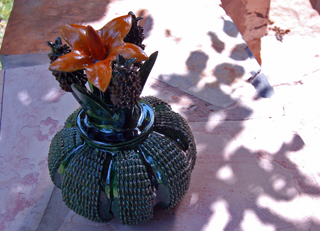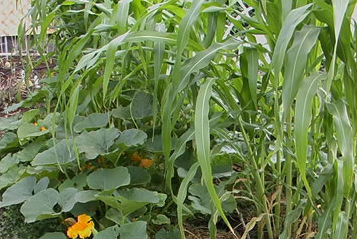Human Flower Project
Saturday, September 01, 2007
Maize and Squash: Polyculture
Across the Americas, small farmers mix crops strategically together to boost yields. Tired of fertilizers? You might give it a try.

Pot with squash flower and maize lid
by Pedro Hernandez Carlos y su Familia
Photo: Human Flower Project
Our neighbor ceramic artist Lisa Orr, also a fine gardener, recently returned from a trip to Michoacan, Mexico. She was there to meet and interview the renowned makers of green pineapple pottery in and around San Jose de Gracia. Among the many beautiful pieces Lisa brought home was a Human Flower Project: a pot topped with ceramic corn tassels and squash blossoms.
This dazzler, made by Pedro Hernandez Carlos & Family, sent us hunting for squash blossom customs from Michoacan state. The golden yellow blooms (flores de calabaza) are enormously popular in the region’s cooking (and in Asian cuisine too).
But more fundamentally, squash and corn have been two of the “three sisters” of indigenous farming—beans, the third sibling. Marti Dodson explains, “Corn, beans, and squash have a unique symbiotic relationship in a Native American garden. Corn offers a structure for the beans to climb. The beans, in turn, help to replenish the soil with nutrients. And the large leaves of squash and pumpkin vines provide living mulch that conserves water and provides weed control. This ancient style of companion planting has played a key role in the survival of all people in North America. Grown together these crops are able to thrive and provide high-yield, high-quality crops with a minimal environmental impact.”

Three Sisters Garden: Squash, Maize, Beans
Photo: The Food Gardener/Darrol Shillingburg
As gardeners, growers, and land stewards learn more about the hazards of monocultures—mile upon mile of single-crop, industrial-scale farming, pumped with fertilizers—there’s new interest in older methods like intercropping. This article chronicles a Three-Sisters kitchen garden and may provide the intercropping novice with a guide. But what if you really hope (or need) to sustain yourself from the garden? “The results of a series of studies has shown that maize yields in corn-bean-squash intercrops can be increased by as much as 50% over monoculture yields. Although the yield for the two other crops was reduced dramatically, the overall yield for the three combined crops was greater than if they were grown separately in monocultures.”
We would appreciate hearing from readers about their own experiments with the Three Sisters (or other symbiotic plant families). Polyculture in many forms seems an idea that’s here to say. Pedro Hernandez Carlos’s pot reminds us what a good idea it is. (Thank you once more, Lisa!)
Art & Media • Cooking • Ecology • Gardening & Landscape • Permalink




